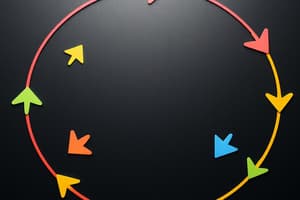Podcast
Questions and Answers
In a circular queue, where are elements added and deleted?
In a circular queue, where are elements added and deleted?
- Added at the front end, deleted at the rear end
- Added and deleted at the rear end
- Added at the rear end, deleted at the front end (correct)
- Added and deleted at the front end
What is the defining feature of a Double Ended Queue?
What is the defining feature of a Double Ended Queue?
- Insertion at the rear end and deletion at the front end
- Insertion and deletion at the front end only
- Insertion at the front end and deletion at the rear end
- Insertion and deletion at both front and rear ends (correct)
What happens when a normal Queue Data Structure becomes full?
What happens when a normal Queue Data Structure becomes full?
- The queue becomes a circular queue
- The queue resets and becomes empty
- No next element can be inserted until some elements are deleted (correct)
- New elements overwrite the existing ones
What is the main difference between a circular queue and a double-ended queue?
What is the main difference between a circular queue and a double-ended queue?
What is the purpose of connecting the last node back to the first node in a circular queue?
What is the purpose of connecting the last node back to the first node in a circular queue?
Study Notes
Queue Data Structures
- In a circular queue, elements are added and deleted from the front and rear ends, respectively, in a circular fashion.
Double Ended Queue
- The defining feature of a Double Ended Queue is that elements can be added or removed from both the front and rear ends.
Normal Queue Data Structure
- When a normal Queue Data Structure becomes full, no more elements can be added to it.
Circular Queue vs Double Ended Queue
- The main difference between a circular queue and a double-ended queue is that in a circular queue, the last node is connected to the first node, forming a circle, whereas in a double-ended queue, this connection is not present.
Purpose of Connecting Nodes in Circular Queue
- The purpose of connecting the last node back to the first node in a circular queue is to utilize the empty space at the beginning of the queue when the front of the queue is empty, making it more memory-efficient.
Studying That Suits You
Use AI to generate personalized quizzes and flashcards to suit your learning preferences.
Description
Test your knowledge of circular queue data structure in this quiz. Explore the concepts of FIFO principle, node connections, and element addition/deletion in a circular queue. Gain insights into Double Ended Queue as well.




